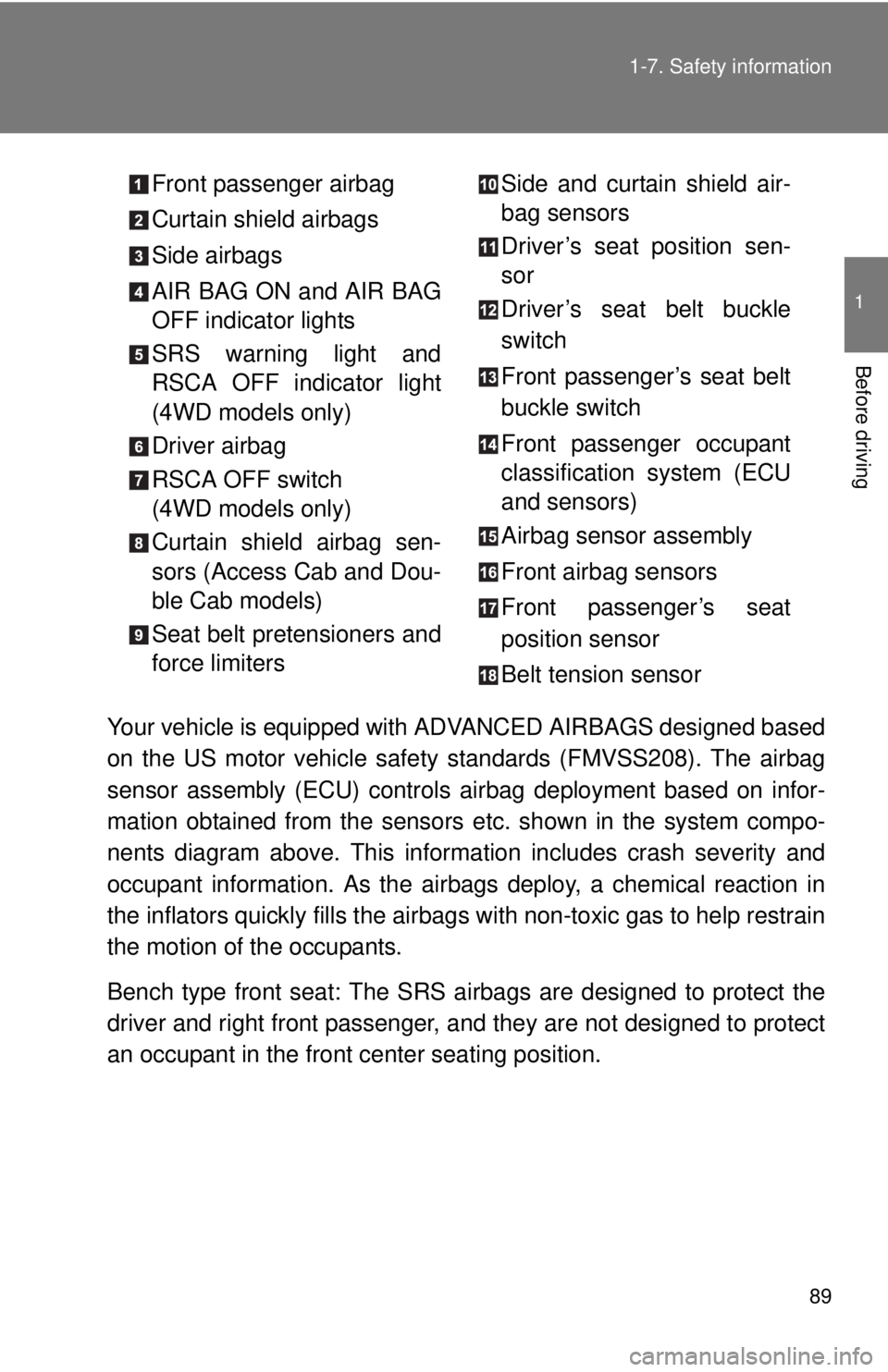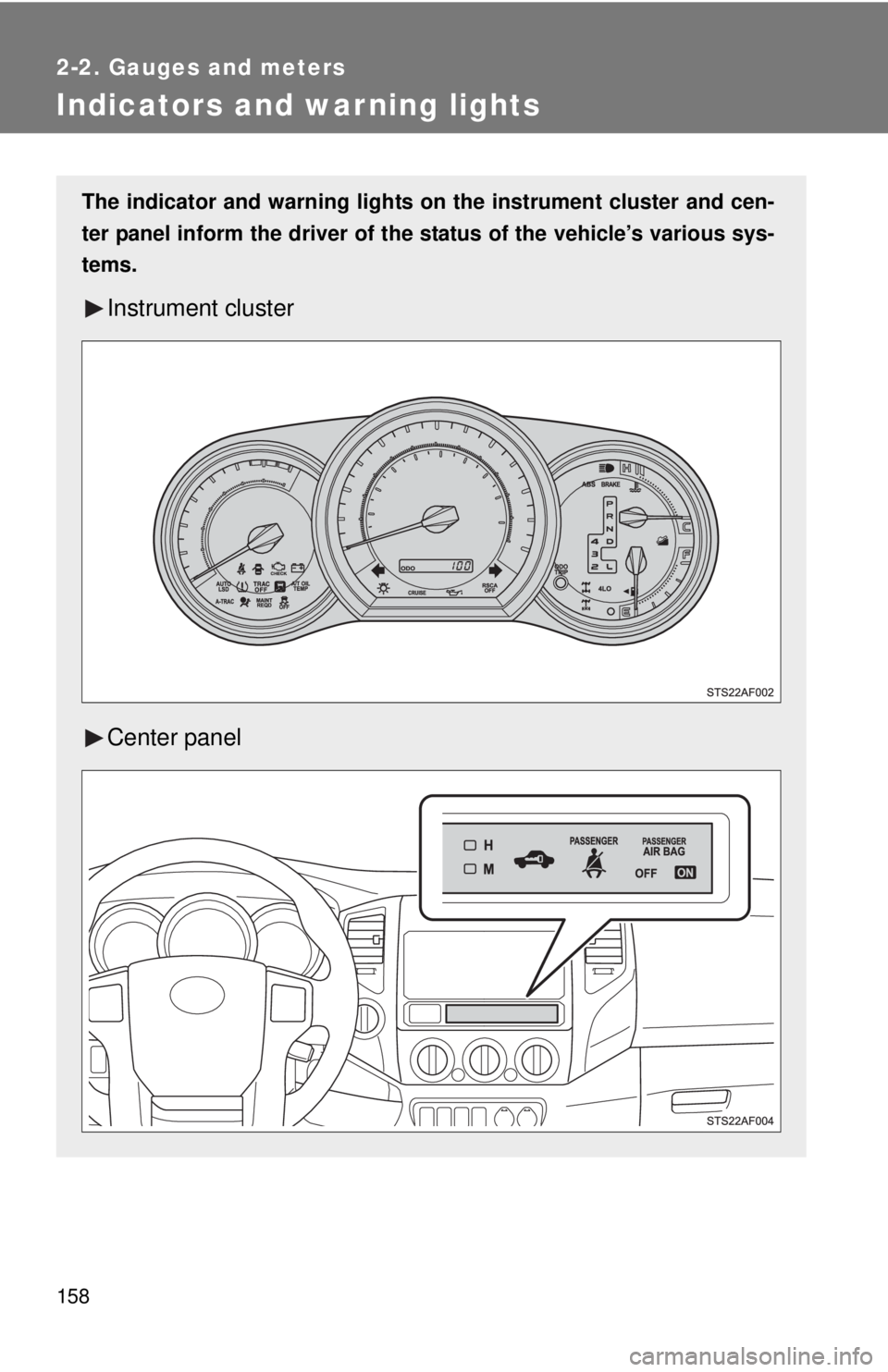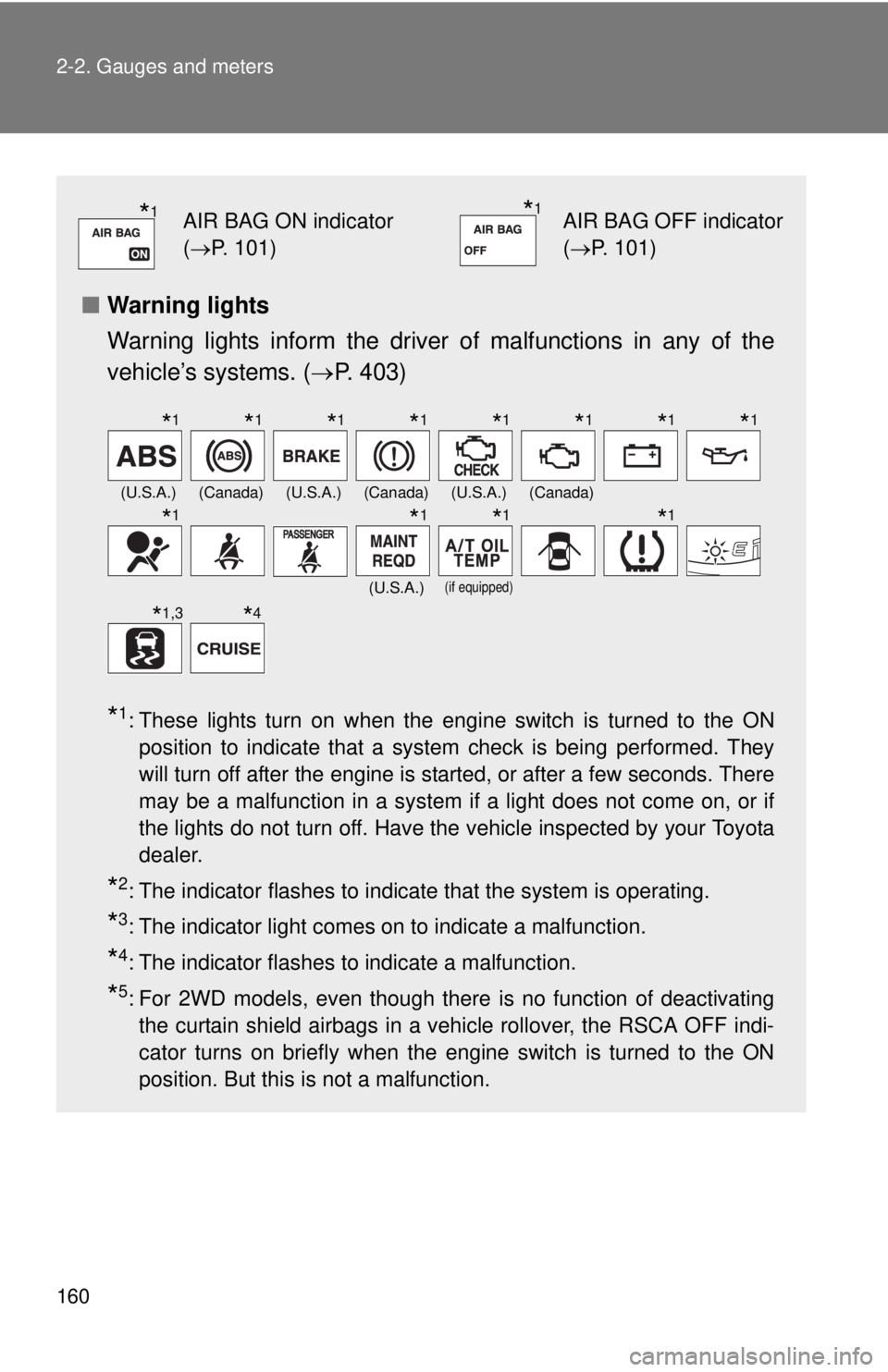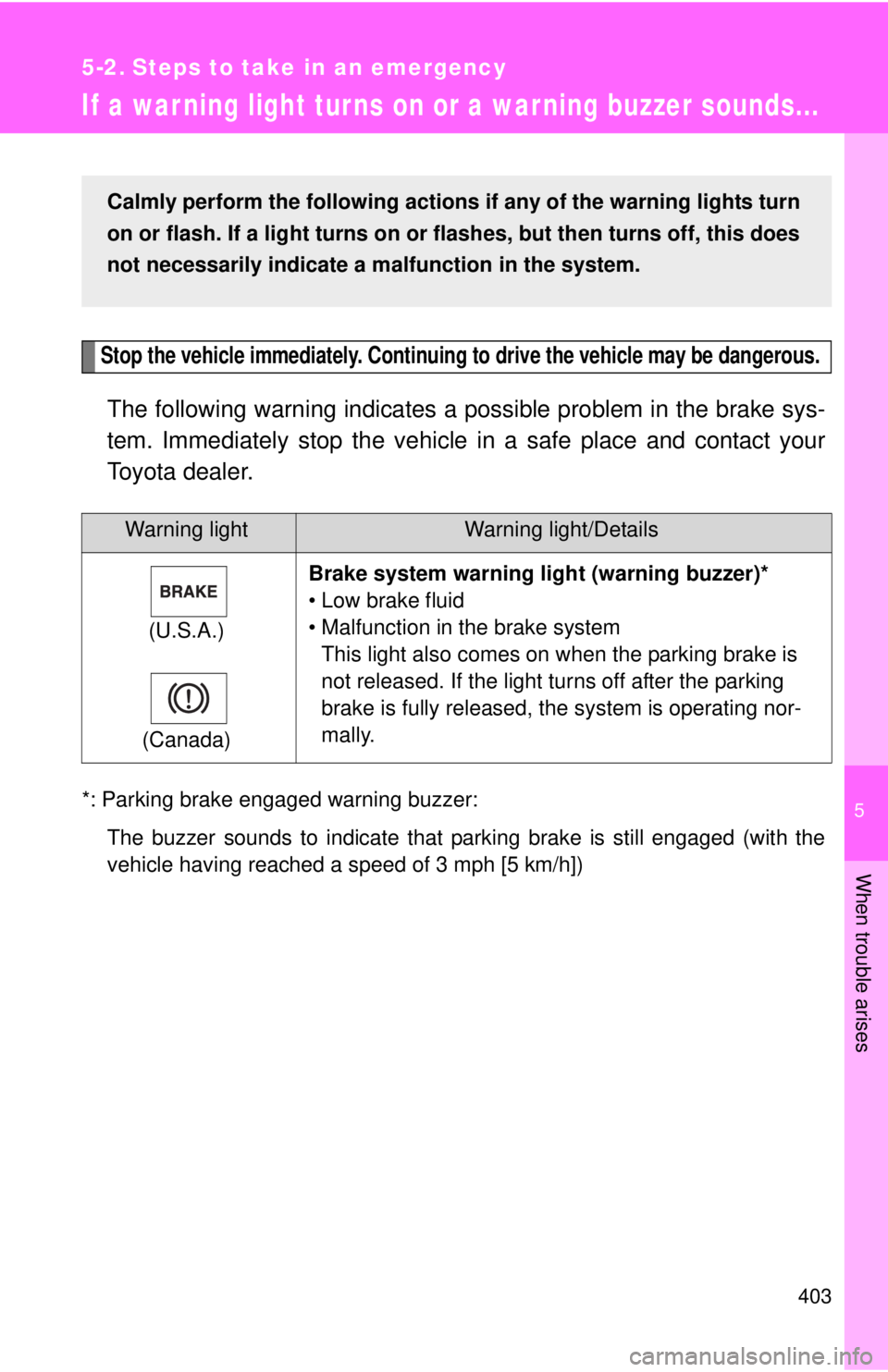warning lights TOYOTA TACOMA 2013 Owners Manual (in English)
[x] Cancel search | Manufacturer: TOYOTA, Model Year: 2013, Model line: TACOMA, Model: TOYOTA TACOMA 2013Pages: 524, PDF Size: 10.96 MB
Page 2 of 524

TABLE OF CONTENTSIndex
2
1-1. Key informationKeys ..................................... 32
1-2. Opening, closing and locking the doors
Wireless remote control ....... 34
Side doors ............................ 37
Access doors (Access Cab models only) ....................... 41
Tailgate ................................ 42
1-3. Adjustable components (seats, mirrors, steering
wheel)
Front seats ........................... 47
Rear seats (Access Cab and Double Cab models) .......... 52
Head restraints ..................... 56
Seat belts ............................. 61
Steering wheel ..................... 67
Anti-glare inside rear view mirror .................................. 68
Outside rear view mirrors ..... 73
1-4. Opening and closing the windows
Power windows .................... 76
Back window (vehicles with sliding type) ........................ 78
1-5. Refueling Opening the fuel tank cap .... 79 1-6. Theft deterrent system
Engine immobilizer system ... 82
1-7. Safety information Correct driving posture ......... 85
SRS airbags ......................... 87
Front passenger occupant classification system ......... 101
Child restraint systems ....... 106
Installing child restraints ..... 110
2-1. Driving procedures Driving the vehicle .............. 130
Engine (ignition) switch....... 141
Automatic transmission ...... 144
Manual transmission........... 148
Turn signal lever ................. 151
Parking brake ..................... 152
Horn .................................... 154
2-2. Gauges and meters Gauges and meters ............ 155
Indicators and warning lights ................................. 158
2-3. Operating the lights and wipers
Headlight switch ................. 162
Fog light switch ................... 165
Windshield wipers and washer .............................. 166
1Before driving
2When driving
Page 89 of 524

89
1-7. Safety information
1
Before driving
Your vehicle is equipped with
ADVANCED AIRBAGS designed based
on the US motor vehicle safety standards (FMVSS208). The airbag
sensor assembly (ECU) controls ai rbag deployment based on infor-
mation obtained from the sensors etc. shown in the system compo-
nents diagram above. This inform ation includes crash severity and
occupant information. As the air bags deploy, a chemical reaction in
the inflators quickly fills the airbag s with non-toxic gas to help restrain
the motion of the occupants.
Bench type front seat: The SRS ai rbags are designed to protect the
driver and right front passenger, and they are not designed to protect
an occupant in the front center seating position. Front passenger airbag
Curtain shield airbags
Side airbags
AIR BAG ON and AIR BAG
OFF indicator lights
SRS warning light and
RSCA OFF indicator light
(4WD models only)
Driver airbag
RSCA OFF switch
(4WD models only)
Curtain shield airbag sen-
sors (Access Cab and Dou-
ble Cab models)
Seat belt pretensioners and
force limiters
Side and curtain shield air-
bag sensors
Driver’s seat position sen-
sor
Driver’s seat belt buckle
switch
Front passenger’s seat belt
buckle switch
Front passenger occupant
classification system (ECU
and sensors)
Airbag sensor assembly
Front airbag sensors
Front passenger’s seat
position sensor
Belt tension sensor
Page 90 of 524

90 1-7. Safety information
■SRS warning light
This warning light system monitors the airbag sensor assembly, front airbag
sensors, side and curtain shield airbag sensor assemblies, curtain shield air-
bag sensor assemblies (Access Cab and Double cab models), driver’s seat
position sensor, driver’s seat belt buckle switch, front passenger occupant
classification system (ECU and sensors), AIR BAG ON and AIR BAG OFF
indicator lights, front passenger’s seat position sensor (Bench type seat),
front passenger’s seat belt buckle switch, front seat belt pretensioner
assemblies, belt tension sensor (Bench type seat), RSCA OFF indicator light
(4WD models only), airbags, interconnecting wiring and power sources.
(P. 404)
■ If the SRS airbags deploy (inflate)
●Bruising and slight abrasions may result from contact with a deploying
(inflating) SRS airbag.
● A loud noise and white powder will be emitted.
● Parts of the airbag module (steering wheel hub, airbag cover and inflator)
as well as the front seats, and parts of the front and rear pillars and roof
side rail, may be hot for several minutes. The airbag itself may also be
hot.
● The front windshield may crack.
■ Operating conditions (front airbags)
● The SRS front airbag will deploy in the event of an impact that exceeds
the set threshold level (the level of force corresponding to an approxi-
mately 12-18 mph [20-30 km/h] frontal collision with a fixed wall that does
not move or deform).
However, this threshold velocity will be considerably higher if the vehicle
strikes an object, such as a parked vehicle or sign pole, which can move or
deform on impact, or if the vehicle is involved in an underride collision (e.g.
a collision in which the front of the vehicle “underrides”, or goes under, the
bed of a truck, etc.).
Page 102 of 524

102 1-7. Safety information
Conditions and operation of the front passenger occupant
classification system
■ Adult*
1
■Child*3 or child restraint system*4
Indicator/
warning light AIR BAG ON and AIR BAG OFF indica-
tor lights AIR BAG ON
SRS warning light Off
Front passenger’s seat belt reminder light
Flashing*2
Devices Front passenger airbag
Activated
Side airbag on the front passenger seat
Curtain shield airbag in the front passen- ger side
Front passenger’s seat belt pretensioner
Indicator/
warning light AIR BAG ON and AIR BAG OFF indica-
tor lights AIR BAG
OFF*
5
SRS warning light Off
Front passenger’s seat belt reminder light Flashing*
2
DevicesFront passenger airbag Deactivated
Side airbag on the front passenger seat
Activated
Curtain shield airbag in the front passen-
ger side
Front passenger’s seat belt pretensioner
Page 103 of 524

103
1-7. Safety information
1
Before driving
■
Unoccupied
■ There is a malfunction in the system
*
1: The system judges a person of adult size as an adult. When a smaller adult sits in the front passenger seat, the system may rec-
ognize him/her as a child depending on his/her physique and pos-
ture.
*
2: In the event the front passenger does not wear a seat belt.
*
3: When a larger child who has outgrown a child restraint system sits in the front passenger seat, the system may recognize him/
her as an adult depending on his/her physique or posture.
Indicator/
warning light AIR BAG ON and AIR BAG OFF indica-
tor lights Not illumi-
nated
SRS warning light Off
Front passenger’s seat belt reminder
light
Devices Front passenger airbag Deactivated
Side airbag on the front passenger seat Activated
Curtain shield airbag in the front passen-
ger side
Front passenger’s seat belt pretensioner Deactivated
Indicator/
warning light AIR BAG ON and AIR BAG OFF indica-
tor lights AIR BAG
OFF
SRS warning light On
Front passenger’s seat belt reminder light Off
Devices Front passenger airbag Deactivated
Side airbag on the front passenger seat
Activated
Curtain shield airbag in the front passen-
ger side
Front passenger’s seat belt pretensioner
Page 129 of 524

When driving2
129
2-1. Driving proceduresDriving the vehicle............ 130
Engine (ignition) switch .... 141
Automatic transmission .... 144
Manual transmission ........ 148
Turn signal lever .............. 151
Parking brake ................... 152
Horn ................................. 154
2-2. Gauges and meters Gauges and meters ......... 155
Indicators and warning lights .............................. 158
2-3. Operating the lights and wipers
Headlight switch ............... 162
Fog light switch ................ 165
Windshield wipers and washer ........................... 166 2-4. Using other driving systems
Cruise control ................... 172
Rear view monitor system (vehicles with auto
anti-glare inside rear
view mirror) .................... 176
Four-wheel drive system ........................... 184
Active traction control system ........................... 188
AUTO LSD system........... 190
Rear differential lock system ........................... 192
Downhill Assist Control system ........................... 195
Clutch start cancel switch ............................. 197
Driving assist systems ..... 198
2-5. Driving information Off-road precautions (4WD models and
PreRunner) .................... 205
Cargo and luggage .......... 210
Vehicle load limits ............ 215
Winter driving tips ............ 217
Trailer towing ................... 221
Dinghy towing .................. 242
Page 158 of 524

158
2-2. Gauges and meters
Indicators and warning lights
The indicator and warning lights on the instrument cluster and cen-
ter panel inform the driver of the status of the vehicle’s various sys-
tems.
Instrument cluster
Center panel
Page 160 of 524

160 2-2. Gauges and meters
■Warning lights
Warning lights inform the driver of malfunctions in any of the
vehicle’s systems. ( P. 403)
*1: These lights turn on when the engine switch is turned to the ON
position to indicate that a system check is being performed. They
will turn off after the engine is started, or after a few seconds. There
may be a malfunction in a system if a light does not come on, or if
the lights do not turn off. Have the vehicle inspected by your Toyota
dealer.
*2: The indicator flashes to indicate that the system is operating.
*3: The indicator light comes on to indicate a malfunction.
*4: The indicator flashes to indicate a malfunction.
*5: For 2WD models, even though there is no function of deactivatingthe curtain shield airbags in a vehicle rollover, the RSCA OFF indi-
cator turns on briefly when the engine switch is turned to the ON
position. But this is not a malfunction.
*1AIR BAG ON indicator
(P. 101)*1AIR BAG OFF indicator
(P. 101)
(U.S.A.)(Canada)(U.S.A.)(Canada)(U.S.A.)(Canada)
(U.S.A.)
(if equipped)
*1*1*1*1*1*1*1*1
*1*1*1*1
*1,3*4
Page 380 of 524

380 4-3. Do-it-yourself maintenance
7 IG1 NO.210 AAnti-lock brake system, vehicle sta-
bility control system, stop lights,
charging system, multiport fuel
injection system/sequential multi-
port fuel injection system, air condi-
tioning system, instrument panel
light control, anti-glare inside rear
view mirror, back monitor, clutch
start cancel switch, rear differential
lock system, power outlets, tire
pressure warning system
8 BKUP LP 10 A Trailer lights (back-up lights)
9 IG1 10 AAnti-lock brake system, traction
control system, vehicle stability
control system, back-up lights, air
conditioning system, shift lock sys-
tem, audio system
10 P RR P/W 20 ARear passenger’s power window
(right side)
11 P FR P/W 20 A Front passenger’s power window
12 WSH 10 A Wipers and washer
13 D RR P/W 20 ARear passenger’s power window
(left side)
14 4WD 20 AFour-wheel drive system, rear dif-
ferential lock system
15 WIP 30 A Wipers and washer
16 D FR P/W 30 A Power windows
FuseAmpereCircuit
Page 403 of 524

5
When trouble arises
403
5-2. Steps to take in an emergency
If a war ning light turns on or a war ning buzzer sounds...
Stop the vehicle immediately. Continuing to drive the vehicle may be dangerous.
The following warning indicates a possible problem in the brake sys-
tem. Immediately stop the vehicle in a safe place and contact your
Toyota dealer.
*: Parking brake engaged warning buzzer:
The buzzer sounds to indicate that parking brake is still engaged (with the
vehicle having reached a speed of 3 mph [5 km/h])
Warning lightWarning light/Details
(U.S.A.)
(Canada) Brake system warning li
ght (warning buzzer)*
• Low brake fluid
• Malfunction in the brake system This light also comes on when the parking brake is
not released. If the light turns off after the parking
brake is fully released, the system is operating nor-
mally.
Calmly perform the following actions if any of the warning lights turn
on or flash. If a light turns on or flashes, but then turns off, this does
not necessarily indicate a malfunction in the system.